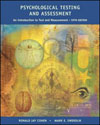Choose the best answer to each question based on material presented in Psychological Testing and Assessment, 5th Edition by Ronald Cohen and Mark Swerdlik.
These questions only sample material from the chapter; there is much more to know than sampled here.
 |
1 |  | 
Objective methods of personality assessment |
|  | A) | yield objective assessments of personality. |
|  | B) | employ validity scales to gauge objectivity. |
|  | C) | characteristically contain short-answer items. |
|  | D) | all of the above |
 |
 |
2 |  | 
Which is NOT a factor that would decrease the objectivity of a respondent's self-report on an objective measure of personality? |
|  | A) | a matching-type format |
|  | B) | a lack of insight |
|  | C) | impression management |
|  | D) | random responding |
 |
 |
3 |  | 
"Individuals supply their own structure to unstructured stimuli."
Stated succinctly, this statement expresses |
|  | A) | the foundation of personality assessment. |
|  | B) | the projective hypothesis. |
|  | C) | the theory of impression management. |
|  | D) | all of the above |
 |
 |
4 |  | 
A difference between objective and projective methods of assessment is that projective methods are |
|  | A) | more artistic and less verbal in nature. |
|  | B) | of value with testtakers regardless of culture. |
|  | C) | indirect methods of personality assessment. |
|  | D) | all of the above |
 |
 |
5 |  | 
The term "projective test" was probably coined by |
|  | A) | Cattell. |
|  | B) | Rorschach. |
|  | C) | Horowitz and Murphy. |
|  | D) | Frank. |
 |
 |
6 |  | 
The Rorschach test consists of 10 bilaterally symmetrical inkblots, |
|  | A) | 5 of which are printed in black-and-white. |
|  | B) | 2 of which are printed in black, white, and red. |
|  | C) | 3 of which are multi-colored. |
|  | D) | all of the above |
 |
 |
7 |  | 
When purchased by a qualified purchaser, the Rorschach test package typically |
|  | A) | comes with little more than the cards themselves. |
|  | B) | contains a brief guide to test set-up and administration. |
|  | C) | contains a complete test manual. |
|  | D) | comes with Rorschach's "Psychodiagnostics" monograph. |
 |
 |
8 |  | 
In administering the Rorschach, the inquiry refers to that part of the examination in which |
|  | A) | the examiner obtains complete demographic information. |
|  | B) | the examiner exposes the cards to the testtaker for the first time. |
|  | C) | the examiner exposes the cards to the testtaker for a second time. |
|  | D) | the testtaker is permitted to ask the examiner any question at all. |
 |
 |
9 |  | 
In the context of Rorschach scoring, which does NOT belong? |
|  | A) | form |
|  | B) | concepts |
|  | C) | determinants |
|  | D) | popularity |
 |
 |
10 |  | 
Today, most scoring of Rorschach protocols is done according to |
|  | A) | principles outlined by Rorschach himself. |
|  | B) | scoring guidelines presented in Oberholzer's monograph. |
|  | C) | Rapaport et al.'s Rorschach Scoring System. |
|  | D) | Exner's Comprehensive System. |
 |
 |
11 |  | 
Evaluating the psychometric soundness of a test like the Rorschach is difficult because |
|  | A) | traditional construct validity evaluation procedures are not applicable. |
|  | B) | traditional test-retest reliability procedures are not applicable. |
|  | C) | the Rorschach taps enduring traits, not transient states. |
|  | D) | all of the above |
 |
 |
12 |  | 
In clinical practice, a TAT examiner administers |
|  | A) | at least 3 cards. |
|  | B) | 10 cards. |
|  | C) | 20 cards. |
|  | D) | as many as he or she cares to administer. |
 |
 |
13 |  | 
Which test employs figure drawings produced by the testtaker as the projective stimulus? |
|  | A) | The Hand Test |
|  | B) | The Rosenzweig Picture-Frustration Study |
|  | C) | The House-Tree-Person |
|  | D) | The Kent-Rosanoff Free Association Test |
 |
 |
14 |  | 
With regard to behavioral observation, |
|  | A) | it may be categorized by how direct it is. |
|  | B) | it may take many different forms. |
|  | C) | it may be accomplished by means of analogue studies. |
|  | D) | all of the above |
 |
 |
15 |  | 
The plethysmograph is |
|  | A) | an unobtrusive measure. |
|  | B) | typically used in conjunction with role play. |
|  | C) | measures changes in blood volume. |
|  | D) | a device employed in pupillometric studies. |
 |



 2002 McGraw-Hill Higher Education
2002 McGraw-Hill Higher Education